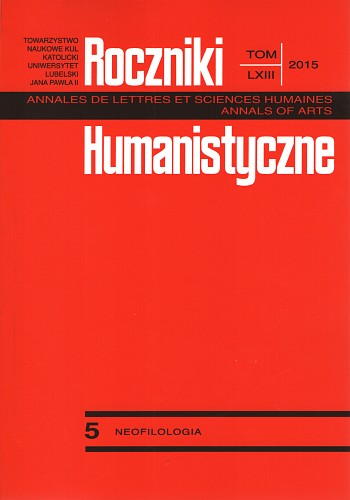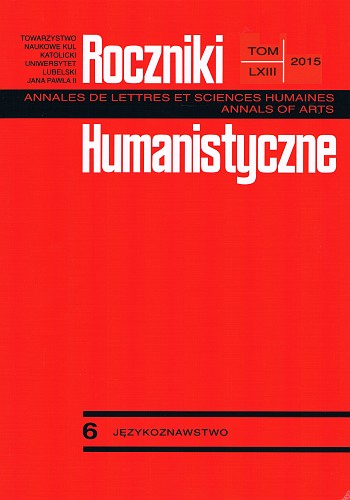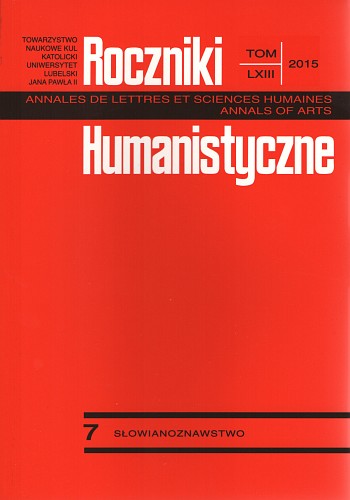




Keywords: individual level predicates;stage level predicates;characterizing predicates;situation-descriptive predicates;APs;density;
The paper examines two typologies of predicates found in the literature, put forward for languages other than Polish, mostly English, Spanish, Russian, and French. The first typology goes back to Milsark (1974) and Carlson (1977), who argue for dividing predicates into individual level and stage level. The former roughly correspond to stable properties, the latter to the transient ones. The distinction has its manifestations in syntax and semantics. The paper shows that the dichotomy is also present in the case of Polish AP predicates. The other typology, that of Roy (2013), posits the distinction between characterizing and situation-descriptive adjectival predicates. The paper demonstrates that this distinction is valid for Polish, as well. The two typologies have been compared with each other. It has been argued that the IL/SL dichotomy allows us to classify a given adjectival predicate as a member of one class or the other, whereas in Roy’s (2013) typology a particular adjective can be either characterizing or situation-descriptive, depending on the context. EAs constitute a class of adjectival predicates that escapes a uniform classification in both typologies under scrutiny.
More...
Keywords: manipulism;André Lefevere;readers’ influence on translation;Harry Potter;Andrzej Polkowski;Tolkien;refraction;
The author of the article shows entanglement of literary translation in various ideologies. Basing on the Internet data she analyzes Andrzej Polkowski’s work over Polish renditions of Harry Potter series and indicates readers’ influence on the final shape of his translation. In her research the author uses terminology and concepts of Manipulation School of Translation, especially those by André Lefevere: refraction, rewriting, intertextuality and patronage.
More...
Keywords: advertising;impression;car;written text;
The author has studied five linguistic-semantic and cultural mechanisms used for the first impression in advertising cars. She has found that these measures aiming at making an impression include: headlines, untypical speech genres, placing the product in a very favorable cultural environment, cumulating valuing utterances and negative advertising.
More...
Keywords: linguistic politeness; language label; linguistic awareness; culture of communication;
This article applies to language and communication awareness of the young generation of Poles in the field of linguistic label. The authors analyze the results of a survey conducted among 100 students of Polish philology. It turns out that they appreciate the importance of linguistic politeness. Irritates them both lack and excess of it. They also point out the wrong vocabulary in language communication, i.e. vocabulary inadequate to the situation and the vulgarisms and curses. Lack of politeness they notice in different situations – everyday and formal (in the media), not only in their peers, but also in the elderly.
More...
Keywords: different ways of communication among hearing impaired people;Polish Sign Language PJM;Polish Signed Language;axiology;
The article presents the problem of different ways of communication between hearing impaired people in Poland. The aim of the text is to discuss not only the ways of communication, but also to present how hearing impaired people perceive and evaluate Polish Sign Language (PJM), Polish (spoken and written) language and Polish signed language (SJM). The analyzed material comes from the website www.deaf.pl, newspaper “The World of Silence” and other texts written by hearing impaired people. The conveyed analysis have highlighted that deaf people are strictly confirmed that PJM is a valuable way of communication. What is more, they claim that PJM is also the symbol of being a deaf person, that is a part of deaf community and culture. They also perceive Polish language and SJM (the subcode of Polish language) as a foreign language, difficult to learn and the language that is imposed by hearing majority. Such negative valuation of SJM and Polish language influence on the perception of bicultural and bilingual education among deaf people in Poland.
More...
Keywords: Christmas;advertising;sacrum;profanum;desacralization;persuasion;
Religious symbols are characteristic for their rich semantic content and many intertextual connections. What is more, religious symbols are strongly embeded in many consuments' minds. In modern advertising the references to religion have mainly persuasive function, as they encourage each recipient to purchase certain goods or to make use of the offered services. Sacrum in Christmas advertisements is rarely presented, because it is very often replaced by regional Christmas customs and traditions. Advertisements undergo different processes of unification and globalization, so they are known and understood by almost every receipient. Elements of sacrum used in commercials enter the profane area and this process is caused by the semantic context that leads to reinterpretation and secularization of the sacrum elements. Only few examples present that this process can be reversed and something that have seemed to be secular becomes sacralised in the advertisements.
More...
Keywords: prayer book;prayer;advertising;catechesis;
The article is devoted to the analysis of an innovative form of the prayer book. It has been given the form of an artifact similar to the cure. In this way it implies a reference to the metaphor the prayer book is a cure.The entirety of the material is treated in the analyses as a collection of genres of unusual contours. The genre characteristics includes the following types of utterances: a collection of texts on a package, a leaflet for the patient and a proper prayer book. The first two types are a contamination of utilitarian genres presenting a cure and catechetical or cult genres, whereas the prayer book refers to the modernized versions of the genre.The author treats the entirety (a collection of utterances) as communication stylized to form an advertisement, yet in the communication sense and not the generic one. A collection of diverse utterances is (just like advertisements): appealing, suggestive, comprehensible and easy to remember.Perceiving the prayer book in terms of a cure and giving it the external form of the medicine results in creation of a new formula of the genre. The genre code of the prayer book has been expanded and supplemented with new exponents. The catechetical discourse (including the integral catechesis) has gained new carriers of persuasiveness by the reference to the advertising discourse.
More...
Keywords: linguistic axiology;the 18th century;paremiology;lexicography;Michał Abraham Trotz;
This article is an attempt to linguistically describe the values occurring in the 18th century proverbs excerpted from Nowy dykcjonarz by Michł Abraham Trotz. The author discusses the axiological preferences reflected in the proverbs, shows which categories and how many of them are emphasized in the proverbs, what linguistic and stylistic means are used to express and estimate of the values, and what aspects of the values are present in the proverbs semantic plan.
More...
Keywords: Jan Jakub Kolski;Johnnie Waterman;auteur cinema;stylisation;folklore;magic;naivety;poeticity;
The aim of this article is to represent an overview of the most important linguistic and stylistic measures used in Jan Jakub Kolski’s “Johnnie Waterman”. The measures that appear both in the short story (which is the predecessor of the movie) and the motion picture are analysed in three categories: folk poeticity, affinity to magic and naivety. The author recalls folk traditions through use of various repetitions, parallelisms and ballads. An atmosphere of magic is achieved by alluding to word rituals (such as curses or namegiving rites), while a feeling of naivety is created by applying common speech to dialogues. It is through the analysis of the aforementioned linguistic means one can prove that the linguistic layer of Jan Jakub Kolski’s works can be included as one of the elements that the director’s auteur style is composed of.
More...
Keywords: neologism;language-game;connotation;polysemousness;stylistic context;
In the article an attempt is made to describe a few stylistic mechanisms responsible for creating language-games in selected poems by Julian Tuwim, Stanisław Młodożeniec, Maria Cyranowicz, Tadeusz Różewicz and Ryszard Krynicki. Also the phenomena are considered that are connected with infringing traditional poetic patterns in Polish lyric poetry of the 20th century.
More...



Keywords: Lermontov;metaphysics;religious literature;Silver Age;the Art of Memory;
In the present article the author attempts to summarise and juxtapose views on Lermontov’s oeuvre formulated by the religious philosophers of the Silver Age. The polemic assessment made by Vladimir Solovyev offered a stimulus to reconsidering Lermontov’s position in Russian national canon. Beginning with Merezhkovsky, interpreting the works of Lermontov in accordance with his own metaphysical philosophical construction, all religious thinkers, including N. Berdyaev, L. Shestov, have reacted to the dilemma “Pushkin or Lermontov”, even if they did so in the form of scattered comments. Religious motifs coded in Lermontov’s prose and poetry, suggest that the sacral code of Russian literature and arts determined his poetics. This is obvious from the project of the composition seen in his foreword to A Hero of Our Time. V. V. Rozanov deemed Lermontov a ‘mystagogue’, whereas the Rev. Florensky, discussing his oeuvre pre-eminently in the framework of his own doctrine on Sophia, addresses the role of ‘titanic’ notion. The Rev. Sergius Bulgakov and S. M. Solovyov clarified facts leading to Vl. Solovyov’s negative assessment. In their writings religious philosophers created a picture sharply contrasting with vulgarised readings afforded by future generations of historians of literature, who strived to make out Lermontov the artist as a vulgarised critic of the social and political atmosphere of his time.
More...
Keywords: emigration;prose;essay;genre synthesis;
This article seeks to address, which reflected the image of Russia in the genres related to essay in the prose of the Russian emigration of the first wave in the 20 – 30-ies; to relate the artistic vision of the artists with the emigrant religious-philosophical thought. It is proved how talented multi-faceted were the emigrant essays: its genre modifications differed in each case, the original artistic synthesis, caused by a deep interest in the substantive basis of national life, to the spiritual nature of Russian life. Sometimes article becomes deep philosophical works, diary entry – an important final reflection on the essential issues, preface to the play of historical and philosophical treatise about the national character. In this case includes other genre elements: actively promoted symbolic images, sounded the implied-associative motives, plot-function performs lyrical. Particularly important role played mythopoetics.
More...
Keywords: Merezhkovsky;a historical perspective;dualism;Triad;determinism;providentialism;
The article focused attention on the analysis of Merezhkovsky’s theory about fate of the people and natural factor and his effect on the life these people – subjects of historical process (determinants and invariance of fate of the people). Discussed also historiosophical and esthetic concepts – connected with historical process: theory of dualism, Triad’s world, ideas The New and The Third Testaments. This article contains analysis the motif of religious revolution as a crucial moment in the history.
More...
Keywords: religiousness;holiness;Russia;narrative strategy;
The article deals with the issue of the religious position of individuals in ‘the Red Wheel’ by A. Solzhenitsyn. The main attention is focused on features of tsar Nicholas II. Analyzing an example of the last Russians Emperor proves that Solzhenitsyn presents the religious theme from patriotic point of view.Despite individual devotion, honesty and even officially admitted holiness of Nicholas II Solzhenitsyn shows rather negative sides of the tsar. According to the writer the Emperor takes responsibility for spreading the revolution and the catastrophe of Russia. The Solzhenitsyn attitude is revealed in the narrative technique, particularly the usage of irony in characterizing of figures. Even tsar’s martyrdom, which is shown in the last part of ‘March 1917’, doesn’t change the specific critical picture of him in the Solzhenitsyn’s epic.
More...